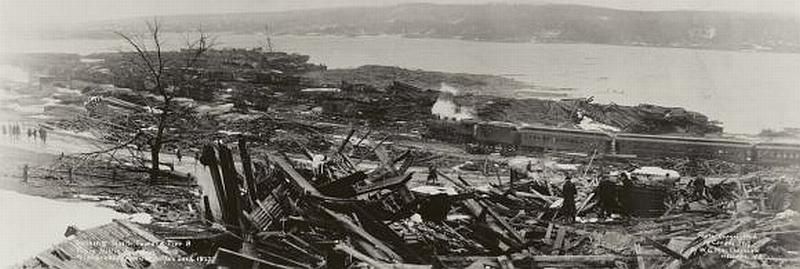 One hundred and five years ago today, on the morning of December 6, 1917, the French freighter SS Mont-Blanc and the SS Imo, a Norwegian ship chartered to carry relief supplies to Belgium, collided in the Narrows, a strait connecting the upper Halifax Harbour to Bedford Basin. The collision at first seemed minor, the two ships hitting at only about a knot.
One hundred and five years ago today, on the morning of December 6, 1917, the French freighter SS Mont-Blanc and the SS Imo, a Norwegian ship chartered to carry relief supplies to Belgium, collided in the Narrows, a strait connecting the upper Halifax Harbour to Bedford Basin. The collision at first seemed minor, the two ships hitting at only about a knot.
Nevertheless, a fire broke out aboard the Mont-Blanc, which was loaded with munitions and high explosives. The fire burned out of control and ignited the cargo, causing the largest man-made explosion the world had ever seen prior to the nuclear age. Roughly 2,000 died and 9,000 were injured. Many thousands more were made homeless. Large sections of Halifax, Nova Scotia were leveled. A tsunami created by the blast wiped out the community of Mi’kmaq First Nations people who had lived in Tuft’s Cove, on the harbor’s eastern shore.
Relief efforts began almost immediately from Eastern Canada and the United States but were impeded by a blizzard. Boston authorities heard of the disaster by telegraph and sent a relief train around 10 pm. The blizzard delayed the train, which finally arrived in the early morning of December 8, and immediately began distributing food, water, and medical supplies. The train from Boston carried some of the first responders to the disaster.
In 1918, a year after the explosion, Nova Scotia donated a large Christmas tree to the city of Boston in thanks and remembrance for the help the Boston Red Cross and the Massachusetts Public Safety Committee provided immediately after the explosion. Another tree was donated in 1971 and trees have been donated to Boston every year since. On December 1, a tree from Nova Scotia was lit on Boston Commons in remembrance of the Halifax disaster 105 years ago and the support and assistance provided by the people of Boston.
It’s here! Tree for Boston, the city’s official Christmas tree, arrives

ta, Capt Rick…here’s a blow-by-blow [sic], pics & witness description …cbc.ca/news/canada/nova-scotia/halifax-explosion-100-anniversary-main-1.4413663
Let us not forget also those who died in the munitions explosions of the HMS Bulwark (778 deaths) and HMS Princess Irene (352 deaths) in the River Medway in south-east England. 26 Nov 1914 and 27 May 1915 respectively.
When I visited the Bedford Road cemetery in 1981 when joining the Norwegian sailing ship `Sorlandet` I was given a lift back into town and mentioned that I had gone to see the 126 `Titanic` graves but found mass graves to the Halifax explosion what was it the lad said he would take me and show me something out of town, Up on a hill above the town was surrounded by iron railings a very large lump of anchor that had come from one of those ships involved a half mile or so from the basin. The follow up to this is that my friend tom Lewis the maritime singer told me that they built houses up there and moved the piece of anchor only to be told that is where it landed put it back so today this memorial is rightfully where it landed.